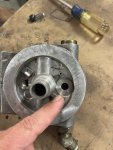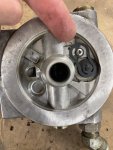With all diesels I start with the basics first. Fuel is life… What does the primer bulb feel like? If the system is full of fuel like it should be, the primer should be firm from the start as you should be hydraulically pushing against the pressure regulator at the far end of the system from the first push. If there is air in there, it will compress and the bulb will feel spongy.
So step one, you need a firm bulb and to find what is letting air in if it is not firm.
On the 3126 LMTV the fuel flows from the tank, to the primary filter where the primer is, thru the fuel lift pump on the HEUI pump, thru the secondary filter and to a port on the front of the cylinder head to feed the gallery. On the back of the head is a pressure regulator and the fuel returns from there to the tank.
The lift pump is a plunger pump driven off of a cam in the HEUI pump. More RPM = more pump strokes). Between the lift pump and the secondary filter there should be a T fitting with a test port. You need to hook a 100 PSI gauge there to check for baseline fuel pressure(I show how to do this in a video linked below). The pressure regulator is a simple spring loaded obstruction that requires a certain amount of pressure to force it open. With the primer bulb you should be able to push it to 10PSI At the test point. while cranking you should see ~10 PSI. At idle 20-25PSI and as you increase RPM it should increase and plant itself at 60PSI.
Step 2 measure primary fuel pressure.
The whole fuel injection scheme is based on this baseline fuel pressure. When there is problems it becomes hard to start and does not run properly. Your video could be explained by this. if a bad leak is mixing in air, the lift pump at its slower idle pulse rate will reach a point where it cannot deliver enough fuel, so you don’t get that 25PSI of hydraulic pressure in the gallery, along with a bunch of air and you cannot feed all the injectors Enough fuel to fire properly. You bump up the RPM and the higher lift pump pulse rate moves more fuel and increases gallery injector feed pressure so the injectors start to work better. It does not take a significant ammount of additional fuel to go from idle to high RPM unloaded though, so I imagine if you tried to run like this under load, the injectors would once again act like they are starved as they would have trouble delivering more fuel…
The fact yours runs better at higher RPM is very telling. I do not believe a HEUI issue or damaged/clogged spool valves on the injectors would work better at higher RPM…
Cat licensed the HEUI system to ford, it is what is found in all the power-stroke diesels. I know in that system, insufficient baseline fuel pressure kills injectors. I have never seen this stated in any cat documentation, but it makes sense that it will also cause damage if not corrected. Why neither manufacturer chose to monitor it is beyond me…
Here are some videos I did on the 3116 fuel system. The 3116, 3126 and C7 use the exact same baseline fuel system. The only real difference is it flows thru the head the opposite direction on the later engines.
Here is what a small air leak looks like on a primary fuel pressure gauge… you will notice this small ammount of leakage is not big enough to really effect the engines ability to run...
if your baseline pressure is good, you will need someone with the cat software to communicate with the ECU to monitor the HEUI pressures and operation…






